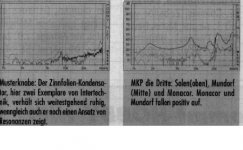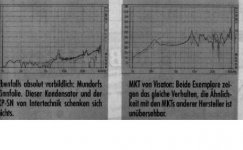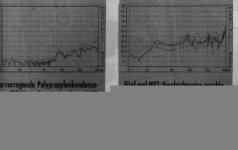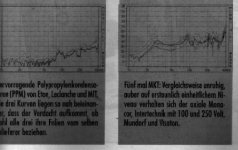On the left a few good axial polypro caps; on the right five different axial MKT(polyester),two of which to me are known as made in the same factory
Intended was a comparison between good mkp and mkt...
------
I am glad to contribute something, sorry for the length
Philipp
Intended was a comparison between good mkp and mkt...
------
I am glad to contribute something, sorry for the length
Philipp
Attachments
It just goes to show - people will go to any lengths to "prove" their paper-in-oil caps and carbon comp resistors are better than anything else - including inventing "scientific" tests.
This is the same b.s. as the wire "resonances" people were talking about years ago regarding cloth-covered wire.
This is the same b.s. as the wire "resonances" people were talking about years ago regarding cloth-covered wire.

John,
posting is no problem.
Bernd Timmermanns published this data in his magazine Hoby-Hifi (formerly he was chief editor of Klang&Ton. He has a rather high credibility with German hobbyists.
The measurements were done with a very sensitive mechanical pickup placed over the objects,
the scales are from 1-40kHz(horizontal)and 120db(vertical)
The author put emphasis on how technologically advanced the mechanical pickup he used was, and also gave a model number
I will have to look the model number, it only happened this topic arose and I still had the graphs on my harddrive
Philipp
posting is no problem.
Bernd Timmermanns published this data in his magazine Hoby-Hifi (formerly he was chief editor of Klang&Ton. He has a rather high credibility with German hobbyists.
The measurements were done with a very sensitive mechanical pickup placed over the objects,
the scales are from 1-40kHz(horizontal)and 120db(vertical)
The author put emphasis on how technologically advanced the mechanical pickup he used was, and also gave a model number
I will have to look the model number, it only happened this topic arose and I still had the graphs on my harddrive
Philipp
Philipp,
So, it is a graph of external mechanical vibration against frequency.
(Thinks for 5 minutes.....)
Don't worry about the model number.
What I'm trying to get here is if there is any significance to the readings.
The outside of the capacitor is vibrating beacuse the "plates" are being forced together and apart by the electrostatic charge, and that is what we detect...
So, in terms of detected relative amplitude:
The vibration will be greater in amplitude if:
The dielectric is hard. (If soft it will absorb).
or
The winding of the capacitor is loose. (If tight the vibration is tensioned).
In terms of frequency:
We should look for the flattest I think.
But in terms of absolute amplitude, we don't know the applied stress, so can't gauge the significance.
What is the applied current / voltage?
What is the value of the capacitor?
So, it is a graph of external mechanical vibration against frequency.
(Thinks for 5 minutes.....)
Don't worry about the model number.
What I'm trying to get here is if there is any significance to the readings.
The outside of the capacitor is vibrating beacuse the "plates" are being forced together and apart by the electrostatic charge, and that is what we detect...
So, in terms of detected relative amplitude:
The vibration will be greater in amplitude if:
The dielectric is hard. (If soft it will absorb).
or
The winding of the capacitor is loose. (If tight the vibration is tensioned).
In terms of frequency:
We should look for the flattest I think.
But in terms of absolute amplitude, we don't know the applied stress, so can't gauge the significance.
What is the applied current / voltage?
What is the value of the capacitor?
MISTAKE??
Infinite Baffle,
Hi,are you sure you did not make a mistake here??
When reading the german text under the graphs it states for the right hand side one that in fact the Visaton cap behaves in an atypical manner compared to other MKP caps.
Have I missed something here?
Thx,
Infinite Baffle,
Hi,are you sure you did not make a mistake here??
Two axial polypropylene caps, one diagram for each brand, the different curves taken from different samples- the author says they behave comparable; these firms may IMO sell the same product, who knows. Also compare these with the susequent diagrams
When reading the german text under the graphs it states for the right hand side one that in fact the Visaton cap behaves in an atypical manner compared to other MKP caps.
Have I missed something here?
Thx,
John,
I hope i can cite further details soon.
"What I'm trying to get here is if there is any significance to the readings."
There should be. It is a relative measurement.
If the effect has a meaning at all.
"So, in terms of detected relative amplitude:
The vibration will be greater in amplitude if:
The dielectric is hard. (If soft it will absorb)."
No, that makes only different resonance frequences. If it is lossy, it is absorbed, but that is what you mean
"or
The winding of the capacitor is loose. (If tight the vibration is tensioned)."
Better coupling of the lossy material?results in better damping
"But in terms of absolute amplitude, we don't know the applied stress, so can't gauge the significance."
Right . However hard to say what is audible and what not
I think all capacitors were 4,7 or all 6,8µF
See you
Philipp
I hope i can cite further details soon.
"What I'm trying to get here is if there is any significance to the readings."
There should be. It is a relative measurement.
If the effect has a meaning at all.
"So, in terms of detected relative amplitude:
The vibration will be greater in amplitude if:
The dielectric is hard. (If soft it will absorb)."
No, that makes only different resonance frequences. If it is lossy, it is absorbed, but that is what you mean
"or
The winding of the capacitor is loose. (If tight the vibration is tensioned)."
Better coupling of the lossy material?results in better damping
"But in terms of absolute amplitude, we don't know the applied stress, so can't gauge the significance."
Right . However hard to say what is audible and what not

I think all capacitors were 4,7 or all 6,8µF
See you
Philipp
No mistake, not yet 
Frank,
"Hi,are you sure you did not make a mistake here??"
No, see below
you wrote:
" When reading the german text ... it states for the right hand side one that ... the Visaton cap behaves in an atypical manner "

No. It says : does behave -not substantially- different, read behaves similar

Philipp
Frank,
"Hi,are you sure you did not make a mistake here??"
No, see below
you wrote:
" When reading the german text ... it states for the right hand side one that ... the Visaton cap behaves in an atypical manner "

No. It says : does behave -not substantially- different, read behaves similar

Philipp
Philipp,Several small caps should allow for better winding stability....
It certainly makes for lower inductance
- Status
- This old topic is closed. If you want to reopen this topic, contact a moderator using the "Report Post" button.
- Home
- Design & Build
- Parts
- i want to replace my wima caps in my valve amp is there better out there





 help! gotta try it
help! gotta try it